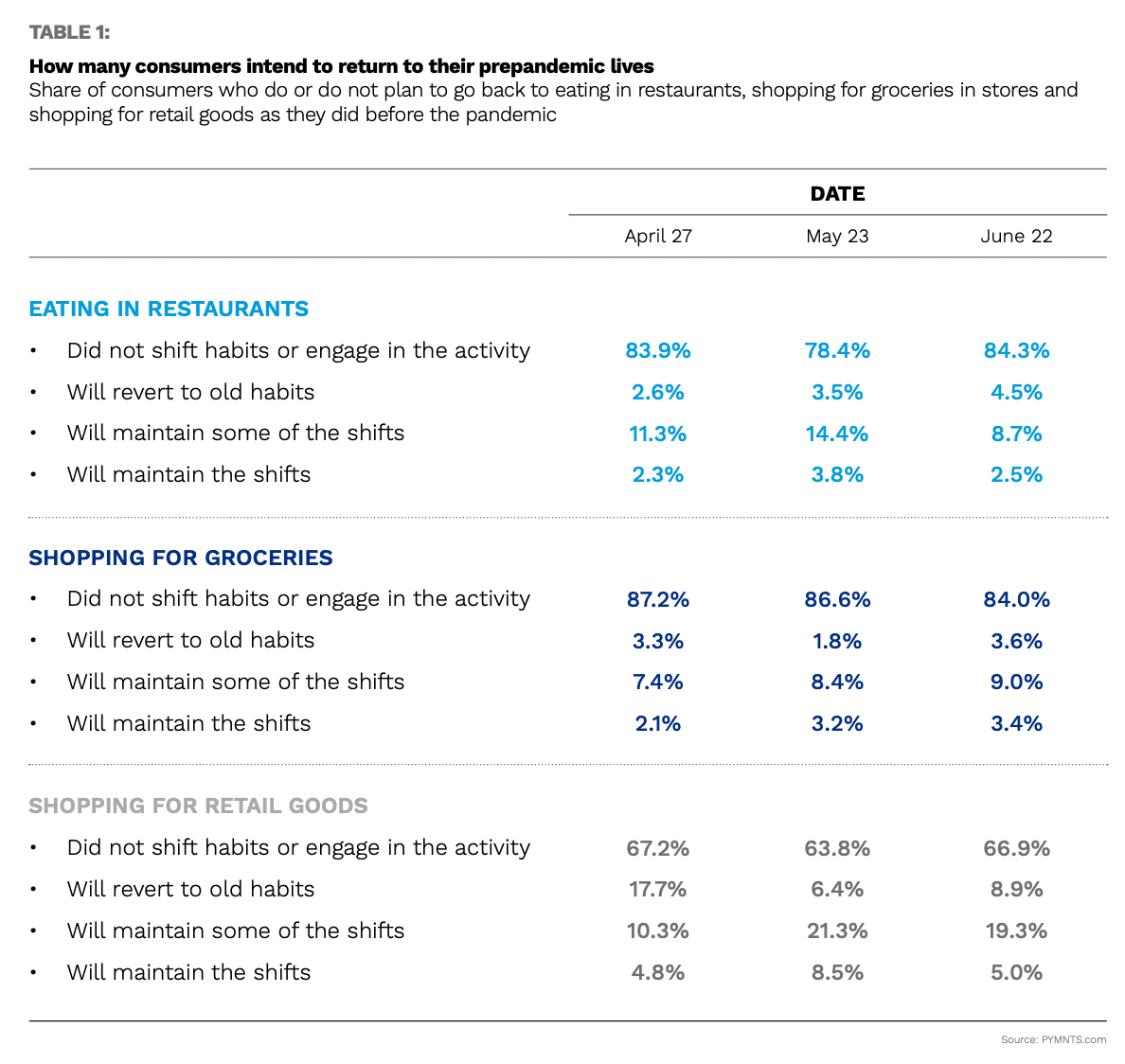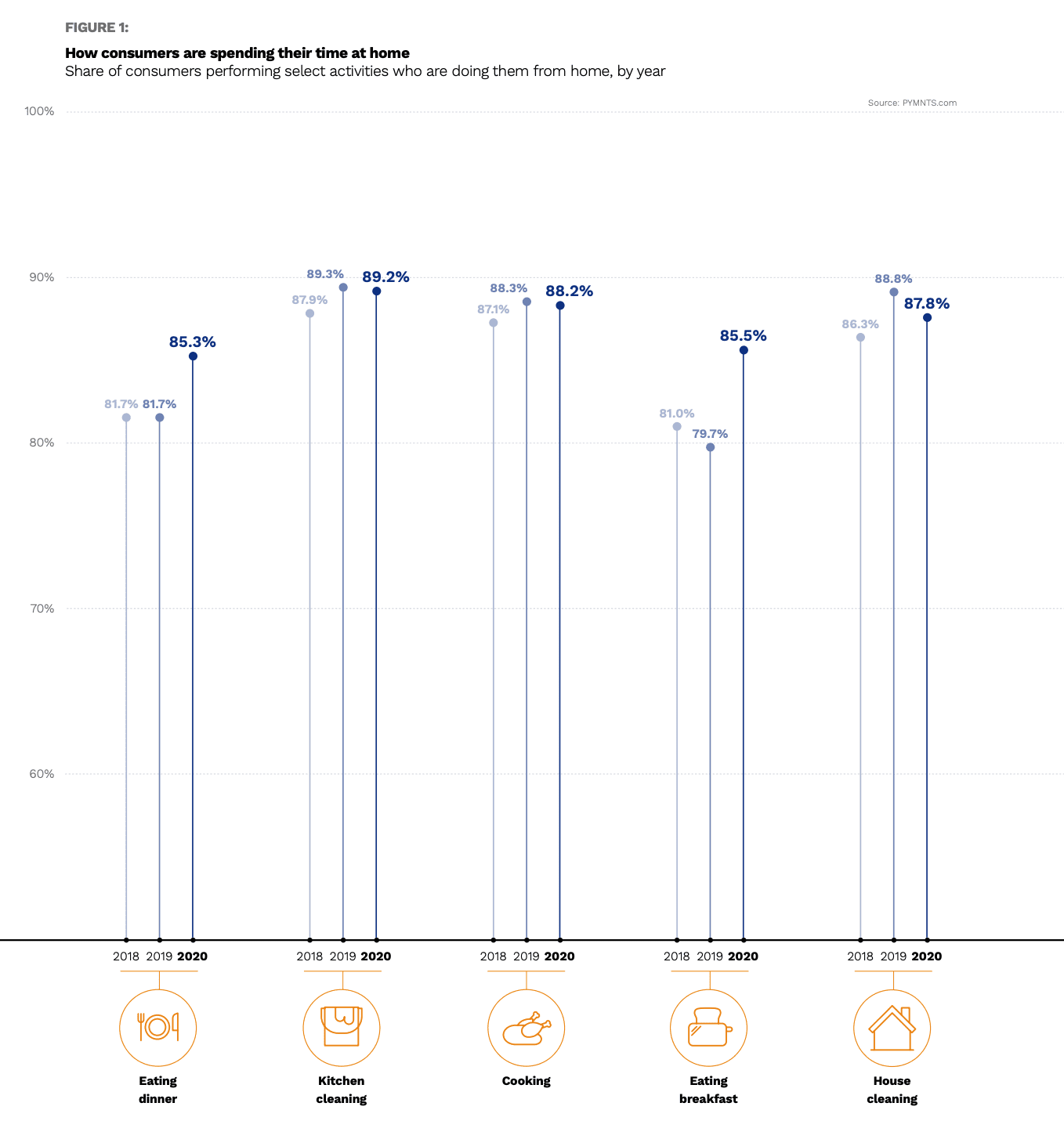What Sticks? Digital-First Changes Show Signs Of Permanence

In years to come, it’ll be hard to find anything as studied and surveyed as COVID-19’s effects on commerce. And while most predictions are at best, informed speculation, certain aspects of life have undeniably kept their appointment with destiny as a result of this pandemic.
Topping that list is digital-first living, which went from some promising pilots to a set of hard deliverables in about four months. Now, with a winter snowstorm coating the northeastern U.S. on Halloween 2020, we’re confronted with the prospect of a long, strange COVID winter.
Many believe this winter will be a big test of which digital-first behaviors endure, and which don’t.
With the average consumer saying the pandemic will have a life of 374 days, some digital-first victors are already obvious. As PYMNTS noted in the Pandenomics report in early October, “the biggest change of all will likely be the share of consumers shopping for groceries online. Our research shows that 85.3 percent of consumers who have shifted to grocery shopping online plan to maintain at least some and possibly all of their new digital shopping habits, meaning only 14.7 percent plan to resume shopping in physical grocery stores.”
Grocery is one of the core areas of American life that appear permanently altered by the pandemic, as are a handful of other digital changes, from how we shop to how we pay.
Payments Innovation Leads The Way
Persuaded by the resilience of online business versus brick-and-mortar counterparts during COVID’s first wave, consumers’ payments preferences combined with ongoing infection fears catapulted a selection of digital technologies into the lives of millions for the first time.
Quaint ‘90s tech, like the QR code, was dusted off and finally found its elusive best use case.
“The convenience of using digital payments such as QR codes resonates so well that one-third of the consumers who prefer them would not even consider making purchases in a physical store without them,” noted PYMNTS’ September 2020 How We Shop Report: Measuring the Rapid Digital Shift, done in collaboration with and supported by PayPal.
 Contactless payments took wing in 2020 and, given the venture capital flowing into facilitating greater payments choice overall, it’s a safe bet that digital-first payments are here to stay.
Contactless payments took wing in 2020 and, given the venture capital flowing into facilitating greater payments choice overall, it’s a safe bet that digital-first payments are here to stay.
Creating digital-first experiences is where intense work is happening on multiple fronts, from global trusted identity concepts to real-time payment schemes that bring digital fully to life.
“The first step, and the most critical, is to put yourself in those shoes and understand what it might be like for someone who isn’t typically used to taking a picture of themselves with a phone or … using their identity documents in the identity verification process,” Trulioo Chief Operating Officer Zac Cohen told PYMNTS during the thick of the pandemic lockdowns.
“Putting yourself in their shoes and really thinking about that persona will allow you to create the best approach regardless of the service you’re providing,” he said.
Envisioning end-to-end digital journeys for consumers and businesses is now the obsession of merchants and financial institutions (FIs) as gift-giving season lurches into view. Payments and banking products were pushed to the head of the digital-first line thanks to the pandemic, leading to the acceleration of contactless and card-not-present commerce.
As Mastercard Executive Vice President of Products and Innovation Jess Turner recently told PYMNTS, “consumers want cards, they want them quickly, and they want those cards [delivered] in a digital way.”
Mastercard expanded its Digital-First Card Program in late September, “[offering] foundational digital guidelines to help several partners – including payment processors FIS, CoreCard, i2c, TSYS (owned by Global Payments) and others – to access card data in a speedy, secure manner. Those processors will in turn work with issuing banks to offer near-instant issuance of cards.”
Superconnected Homes As Digital-First Command Center
As lockdowns and fear kept people at home, much of the commercial world quickly got its act together around products and services for the burgeoning superconnected home command center.
As PYMNTS reported in the recent fourth annual installment of How We Will Pay, a Visa collaboration, “[the] share of consumers who report shopping and paying for retail purchases from home has doubled over the last 12 months, and the share of grocery shopping from home has tripled. Thirty-eight percent of consumers who shopped for retail products during the period of study, some 46 million Americans, did that shopping from home, more than twice that of those who did so in 2019. Thirty-eight percent of consumers who shopped for groceries during the time [in] which our study was conducted, accounting for more than 42 million Americans, are now shopping for groceries from home — more than three times as many who did this time a year ago.”
 In early October, PYMNTS CEO Karen Webster wrote, “these digital-first consumers, this new digital advance guard, define certainty and predictability in new ways,” adding that “new PYMNTS research suggests that this shift to digital now foreshadows a more permanent change in how consumers shop and even order and eat food at restaurants. These are the results of the 13th study PYMNTS has conducted since March 6. Each study examines consumer behavior about the shopping and dining behaviors of a national sample of now roughly 30,000 U.S. consumers, as well as the behavior of a sample of Main Street business owners.”
In early October, PYMNTS CEO Karen Webster wrote, “these digital-first consumers, this new digital advance guard, define certainty and predictability in new ways,” adding that “new PYMNTS research suggests that this shift to digital now foreshadows a more permanent change in how consumers shop and even order and eat food at restaurants. These are the results of the 13th study PYMNTS has conducted since March 6. Each study examines consumer behavior about the shopping and dining behaviors of a national sample of now roughly 30,000 U.S. consumers, as well as the behavior of a sample of Main Street business owners.”
Webster noted, too, that “using digital-first channels to shop for retail products and order food from restaurants using aggregators is two to two-and-a-half times better than consumers reported just three months earlier, at the end of May. For grocery, consumers report that their digital-first and touchless experiences are now nearly two times better” for the same period.
That steadily improving customer experience is reflected in the lasting popularity of mobile order-ahead and delivery aggregator apps charted in PYMNTS’ Provider Rankings.